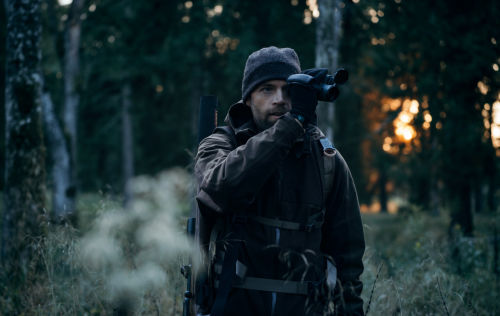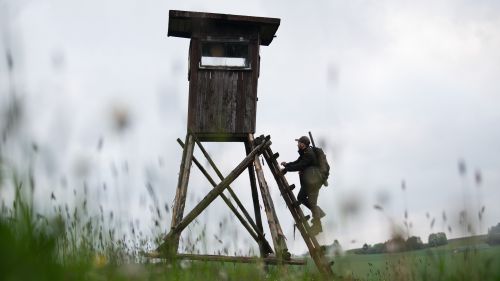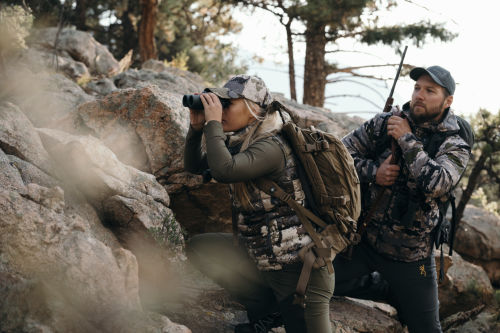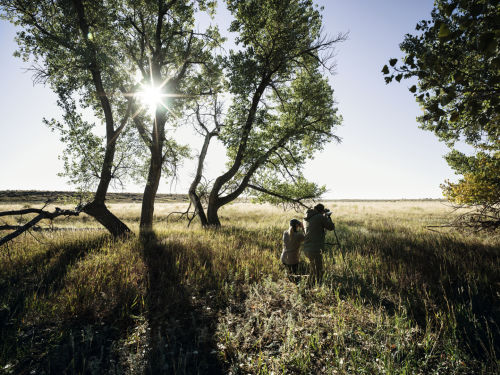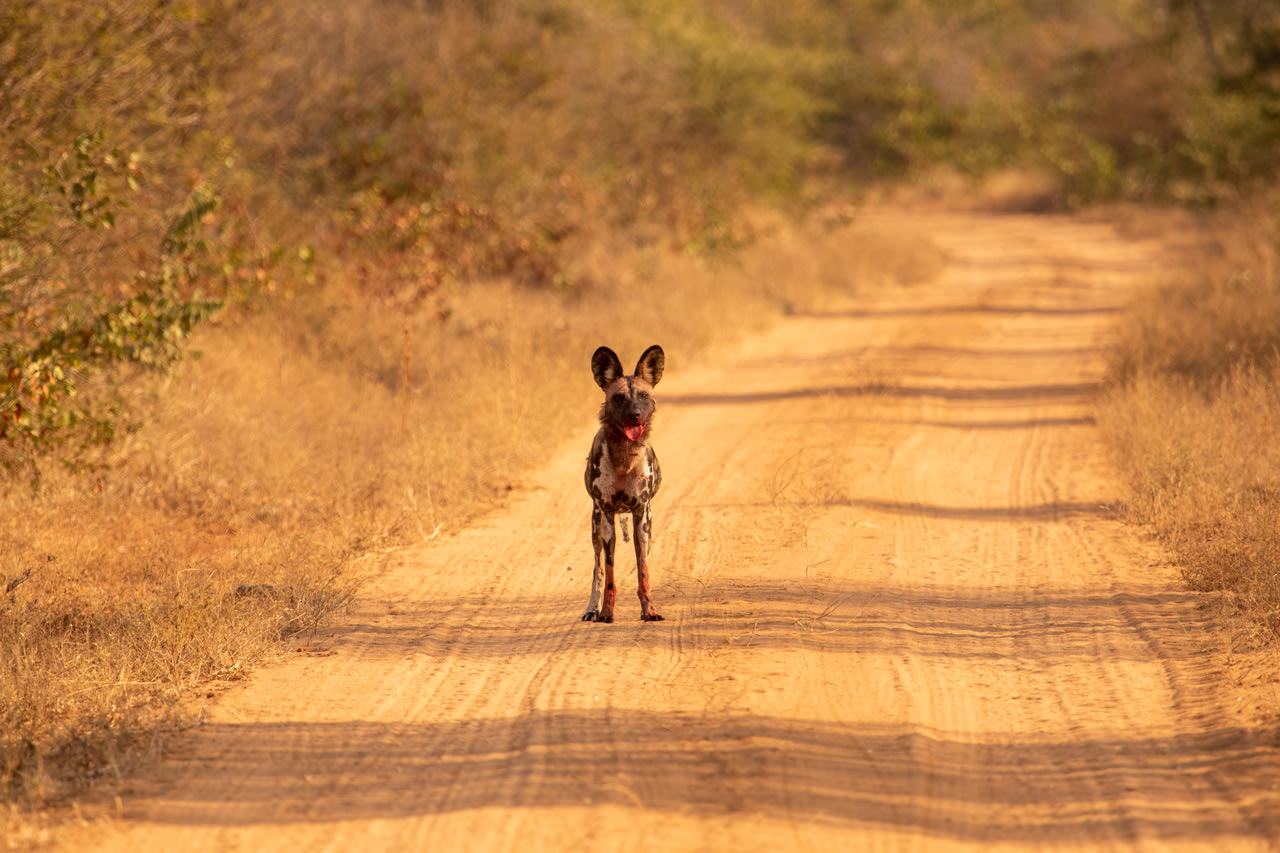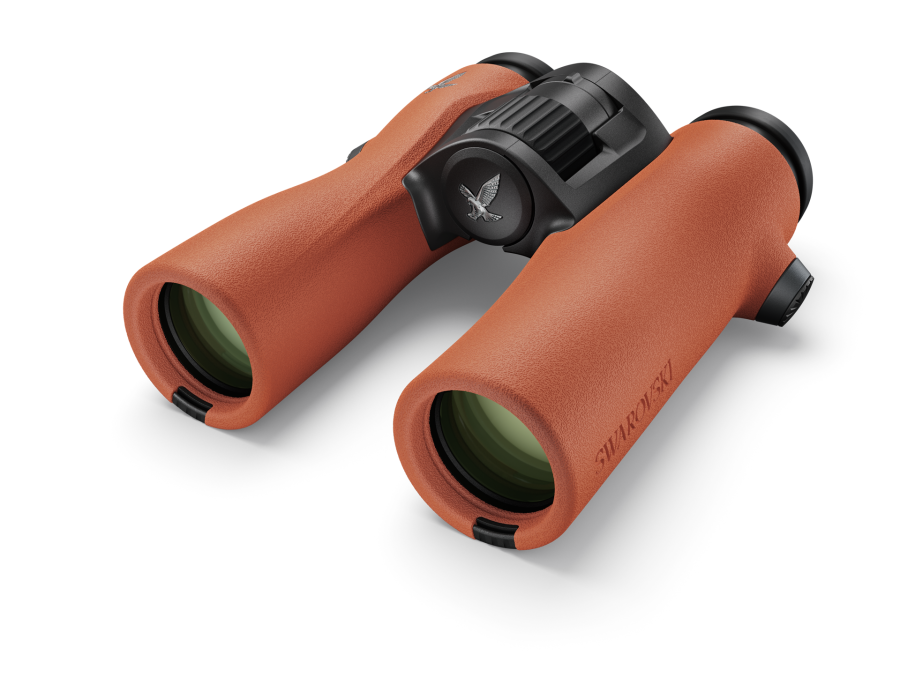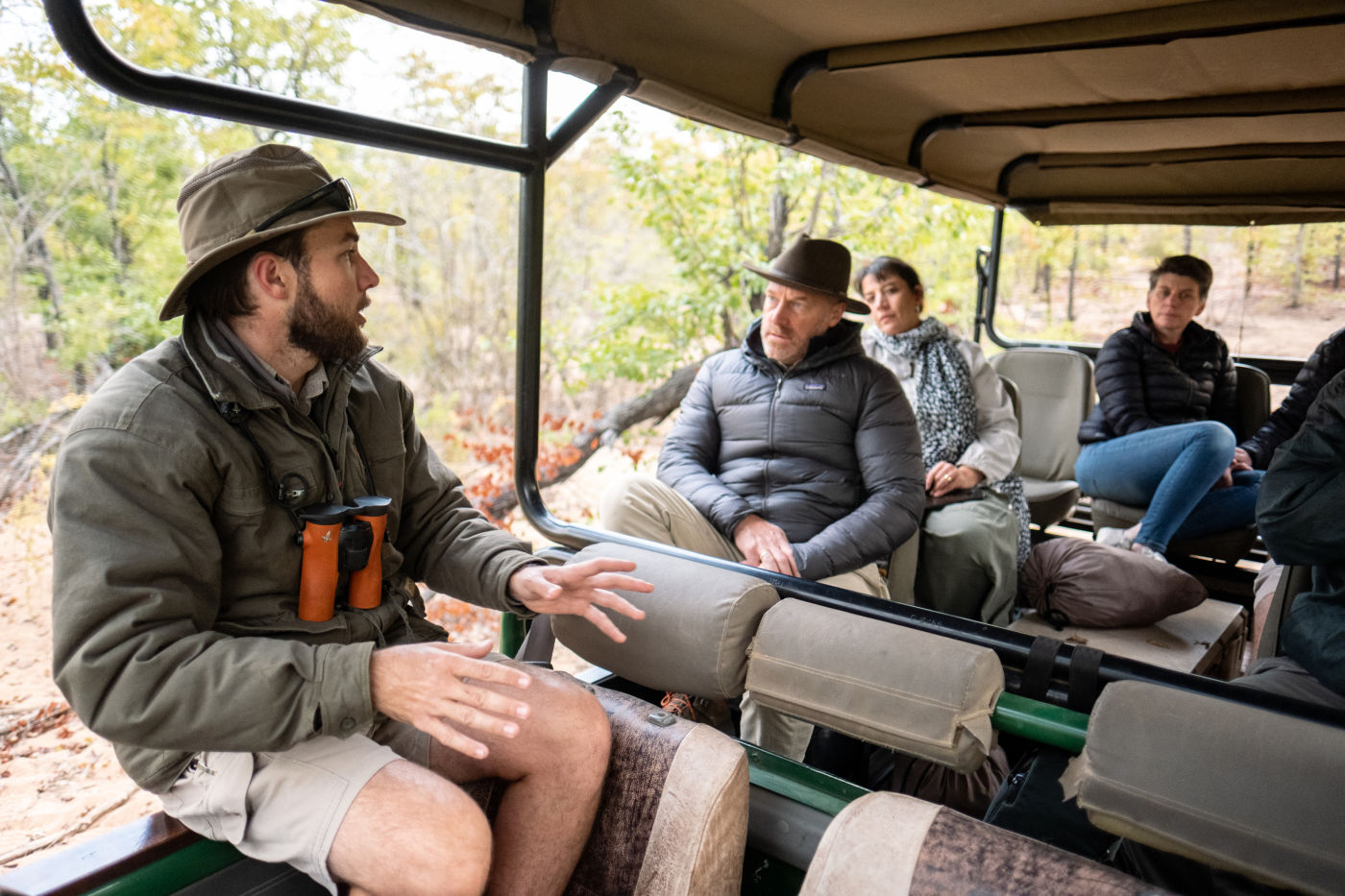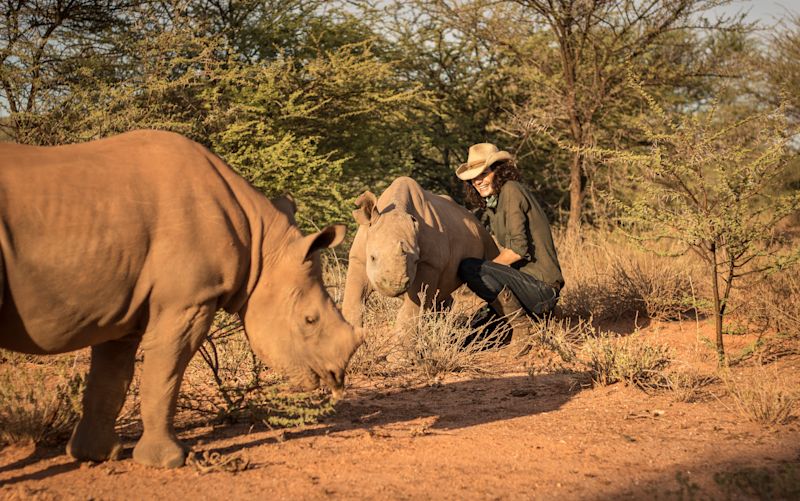From “laughing” hyenas to encounters with lions, from rhino ear notching to visiting a pack of wild dogs – spend a day with our guide Jean in the untamed wilderness of Sango, Zimbabwe.
Morning adventure: from a game drive to a walking safari
It is six o’clock in the morning and pretty cold in the Sango Dadiso Camp, where a group of safari tourists carrying coffee cups, cameras, and binoculars has gathered around the hood of a green Toyota Land Cruiser to discuss the day ahead with Jean. The schedule consists of a morning game drive and picnic followed by a walking safari, where we will try to track one of Sango’s many rhinoceroses on foot. After a short lunch break in the camp, in the afternoon we set out to visit the wild dogs, who are rearing their young in a dense mopane forest.

For three years, along with a team of other guides, Jean has been leading game drives and walking safaris in the Sango Private Game Reserve. The nature reserve in the southeast of Zimbabwe is located away from tourist trails in the Great Limpopo Transfrontier National Conservation Area, which connects the Kruger National Park in South Africa and the Gonarezhou National Park on the border between Zimbabwe and Mozambique with Sango. The Sango Reserve covers an area of 600 square kilometers (60,000 hectares) and is home to leopards, lions, elephants, rhinoceroses, hippopotamuses, and the endangered wild dogs. Zimbabwe is well-known as a safari destination for its guided walking safaris, which take visitors on foot through the nature reserve. Participants’ safety is ensured at all times by Zimbabwe’s safari guides who receive the best training worldwide, with a five-year course of study encompassing visitor care as well as animal biology and nature. Guides such as Jean know each of the seven Sango vegetation zones and have an intuitive sense of where which animals can be found. “Of course, out on safari, we can’t guarantee that we will see the Big Five on any one day, but thanks to good communications with our field rangers on Sango, we have a pretty good success rate,” answers Jean with a smile. The group has climbed into the open Cruiser with a tarpaulin cover. On the horizon, the crimson sun battles through the mist between the bare branches as Jean starts up the Toyota to embark on the day’s adventure.
After a thirty-minute drive, Jean stops the Land Cruiser at a waterhole. He signals to the group with a quick movement of his arm. They too then spot the elephants leisurely making their way to the waterhole. The seven-strong herd drinks carefully, without taking their eyes off the Cruiser. Everyone watches the scene through their binoculars and enjoys this moment completely alone with the elephants. “On Sango, our focus is precisely these private moments when we can observe wildlife with no other vehicles or visitors around,” whispers Jean. “Only 32 visitors are permitted at any one time on the entire Sango Reserve.” He goes on to explain the strong social bonds among the elephants, the fact that herds are led by the females and that there are some 2,200 elephants on Sango. “A fully-grown bull can drink up to 200 liters of water a day,” he says quietly, while his passengers take photographs and marvel.


Tracking wild rhinoceros on foot
After a quick picnic, the Land Cruiser moves off, leaving the elephants behind, before quickly stopping at the edge of a sandy trail. Time for the walking safari. Participants pull out cameras and binoculars, jump out of the truck and gather around Jean. The excitement of continuing the safari without the protection of the vehicle is clearly visible in their eyes.
“There are two rules when we’re walking through the bush,” says Jean M. Blake, looking deeply into everyone’s eyes. “First: from now on, you do exactly what I tell you. Second: we will be walking in a tightly-spaced single file. I go first and nobody stays behind,” he adds, putting his firearm over his shoulder as the group sets off.

Rhinoceros tracks in the sand and two rules
Jean raises his NL Pure binoculars and scans the surrounding area for rhinoceros tracks, while his safari party wait eagerly behind him – in perfect file formation, of course. “A rhinoceros was sighted near here this morning,” says Jean quietly. He bends down and points to several tracks in the sand which cross the path and then disappear into the tall brown grass on both sides of the track. Jean has picked up the trail.
As the group make their way deeper into the bush, Jean suddenly raises his right arm and signals to change direction. He leads the group out of the wind that is coming from behind to make it more difficult for the unpredictable animals to detect their scent. He then lifts his binoculars and points straight ahead. Directly in front of him, he sees what they have been looking for – a rhinoceros, effectively camouflaged in the dry, gray undergrowth.
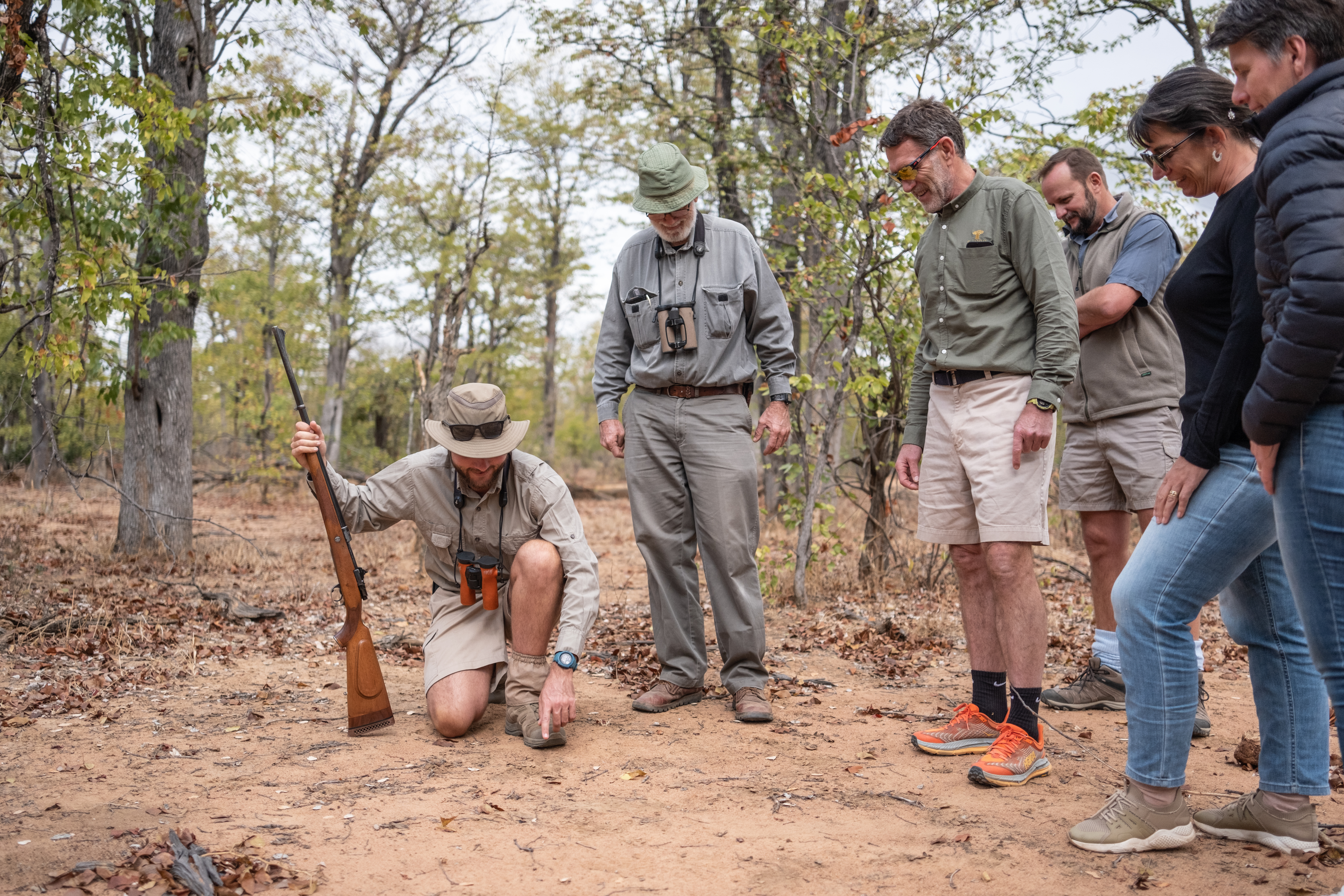
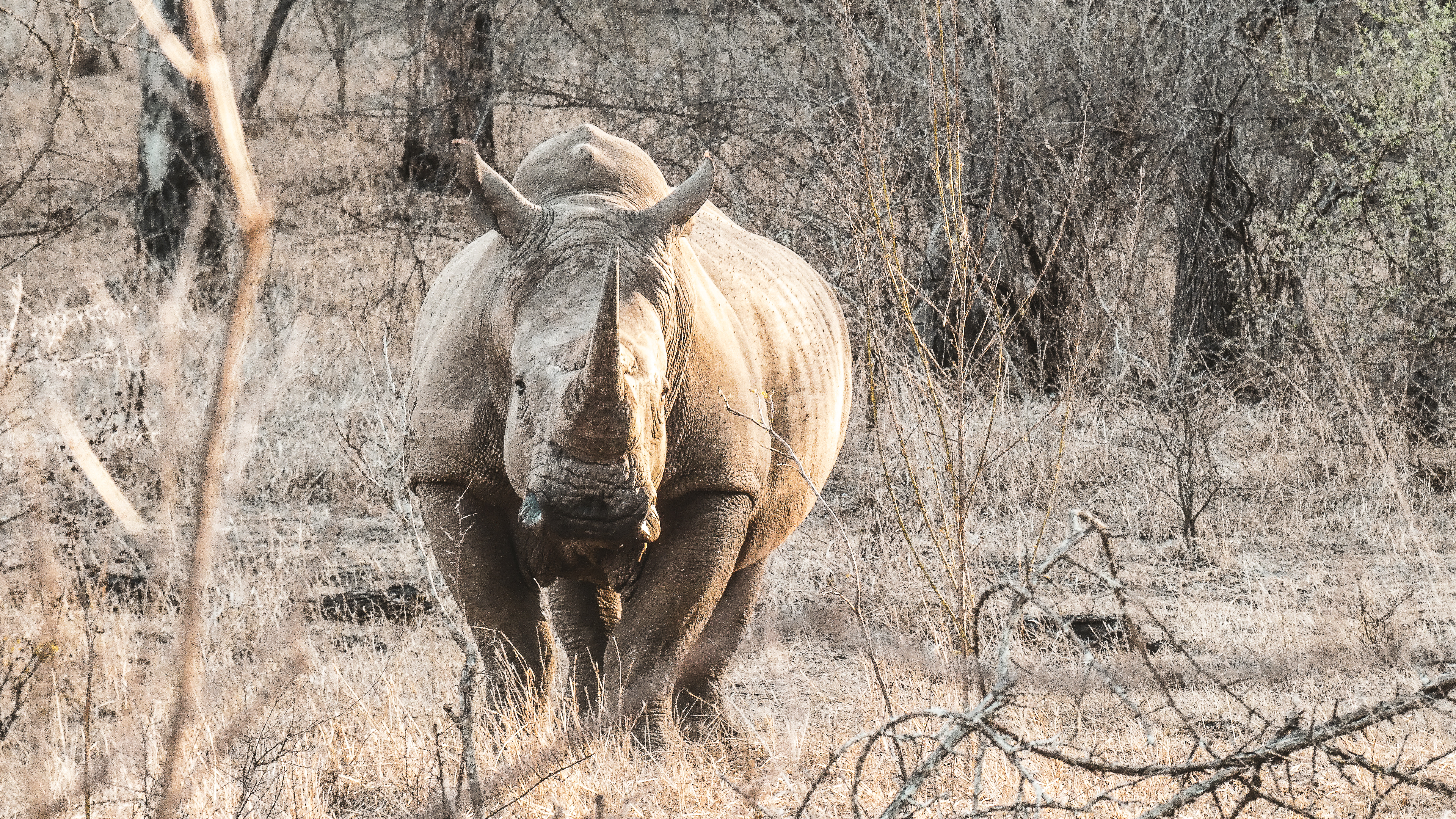
Rhinoceroses with license plates
The impressive animal stays completely still and seems to be smelling something. The sense of tension in the group is palpable, no-one moves and it’s so quiet you can hear the dry leaves rustling on the ground. “Look at the ears, can you spot anything?” whispers Jean and everyone very quietly picks up their binoculars. “There are notches in them,” whispers someone. The notches are used to identify the endangered animals. Every year in August, the young rhinoceroses on Sango are anesthetized from a helicopter, marked by a ground team of vets and helpers, then released again 10 minutes or so later. The animal is sedated during the bloody process and barely aware of the notching of its ear. This procedure is the only time the animals on Sango come into contact with humans, yet it has huge significance for the future of these thick-skinned animals. “Each notch stands for a number, and the total provides a value that can be assigned to just one specific animal,” explains Jean, taking a little card from his bag and writing down the value. He will later report the numbers to head office in Sango which keeps precise documentation of all rhinoceros sightings. The purpose is to monitor the population and develop measures to protect it. “Our rhinoceroses have license plates in their ears,” jokes Jean quietly, and after a few more minutes with the gray giants, he gives the group the signal to leave.

Rhino ear notching
Rhinoceros license plates
Ear notching is used for identification.
Each notch and every pattern stand for a number which in total makes each rhinoceros unique.
The ear-notching is practically painless for the animals as they are sedated during the procedure.
Every sighting on Sango is reported to a central register for documentation.
After a short break for lunch and some time at the pool in the Dadiso Camp, at around 4 pm, the group continue toward some woodland where, just two days ago, the wild dogs had led their offspring out of the breeding burrow. The site is located in a densely vegetated area and the thorny branches scrape over the Cruiser’s paintwork as the group slowly approach the burrow. Jean apologizes for the difficult journey with springing branches and explains that the branches and trees on the access route are deliberately not cut back to avoid clearing a path for other predators to reach the wild dogs. The vehicle comes to a stop in front of a mound of earth. It is now a question of waiting.
After around 15 minutes, things suddenly happen very quickly. Making whimpering sounds, the spotted dogs trot toward the mound from two directions, almost appearing to float. A short time later, two dogs run right past the Cruiser and the group gathers. The hunting party was successful, as we can clearly see from the blood of the prey on the dogs’ lips. Everyone watches spellbound through their binoculars, we then see the little wild dog pups emerging from the burrow on unsteady legs and being rounded up by the adult dogs. The adults carry the hunted meat to the pups in their stomachs. They then regurgitate it and allow the little ones to eat their fill.
At the campfire, it’s time to plan the next day.
Jean perches on the door of the jeep and explains that wild dogs, with a success rate of almost 90 percent, are Africa’s most efficient hunters and highly social animals that look after each other and even care for injured and weak members of their pack. With these words, he smoothly leads the participants over to the barbecue waiting for them in the camp, starts the engine, and slowly backs up. An eventful day is coming to an end. And according to Sango tradition, after the meal at the campfire, there is a discussion over a gin and tonic of where the safari should go the next day. Everyone agrees that the plan for tomorrow is to set out in search of the lions who live right next to the camp and can be heard clearly every evening.
SWAROVSKI OPTIK supplies the rangers of the Sango Wildlife Conservancy with binoculars to support their efforts to maintain diversity.

ABOUT THE AUTHOR
Henning Pommée
Henning Pommée, a communications and marketing expert, and nature lover, lives in Germany and has been working for Sango since 2017. Whenever possible, he spends his time with the talented Sango team in Zimbabwe developing unique experiences for visitors focusing on conservation tourism. Precious insights into conservation of nature and wildlife in Africa are guaranteed!
He developed his latest project together with Kim Wolhuter, the award-winning filmmaker and TED talk presenter who, as well as hyenas, also loves unconventional filmmaking. Kim lives with his wife and daughter on Sango. He is responsible for the astonishing wild dog photos featured in this article. Thank you very much!
For more information, you can contact Henning by email at henning@sango-wildlife.com and Kim through his Facebook page: @kimwolhuter1
